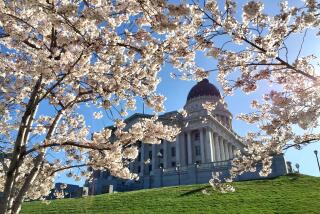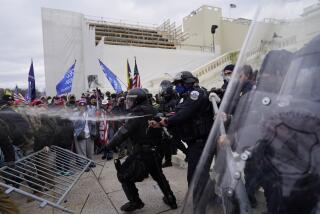Why the U.S. Capitol dome needs a $60-million restoration

Corrosion has heavily damaged the Capitol dome.
The scaffolding that has wrapped the U.S. Capitol like a wiry cage for more than a year has become part of this city’s landscape, giving the domed symbol of American democracy an eerie evening glow and altering the backdrop for thousands of live news reports beamed around the world.
The nearly $60-million restoration project started with a coffee can full of rust. Alan M. Hantman, who served as the Capitol’s architect from 1997 through 2007, used to carry the can of corrosion that had come from the inside of the dome to congressional hearings, to show his bosses that their workplace was crumbling above them.
Many of the bolts atop the iron dome, which was built more than 150 years ago and weighs nearly 9 million pounds, had simply fallen off. Metal straps installed to reinforce the cast iron sheets had themselves cracked.
“Cast iron parts were basically holding each other in place,” Hantman said by phone from Fort Lee, N.J., where he lives.
Hantman took precautions, installing a wooden rail just below the Statue of Freedom atop the dome so that elite tourists who climbed near the top on special tours with members of Congress would not jog anything loose.
“We didn’t want people leaning on the railing up there,” he said.
But it would take more than a decade before Hantman’s successor, Stephen T. Ayers, could secure the funding and begin repairing cast iron, rebuilding ornaments, stripping away layers of paint that began building up more than a century ago, and replacing some heavy glass windows that look out at this city of monuments.
The dome had not been renovated since 1959-1960. Since then rust has accumulated. Rain and snow worked their way into tiny holes in the cast iron, enlarging them, leaving more than 1,000 cracks.
NEWSLETTER: Get the day’s top headlines from Times Editor Davan Maharaj >>
Workers began erecting the 1.1 million pounds of scaffolding — enough pipe to stretch 52 miles long — in May last year. Inside the dome, they installed a puffy cloth just below the ceiling for interior renovations, with a doughnut hole in the middle that enables visitors to see the historic mural in the eye of the rotunda.
Hantman, who supervised the building of an underground visitor center that expanded the Capitol by 70% during his tenure, calls working there a “magnificent challenge,” full of logistical and political hurdles unheard of elsewhere.
Members of Congress worry about spending money, and unrelated issues often get thrown into the decision-making process. During construction, they still need access to meetings and votes. They want tours for their constituents.
The trucks that enter the grounds and the hundreds of workers who staff them have to be screened every day, cutting into their working hours. Before they’re even allowed on-site, these workers need to pass criminal background checks that go beyond a typical job.
All the while, the building needs to be one of the most secure facilities in the country.
To minimize disruptions, much of the work has been done at night and on weekends. The rotunda has largely remained open to visitors and staff, closing for only a few weeks in April 2014 to hang the cloth canopy.
But few argue that it’s not worth the effort.
“During the Civil War, Lincoln never gave up on it,” said Rep. Zoe Lofgren, a San Jose Democrat who sits on the Committee on House Administration, which oversees the project. “We need to make sure it doesn’t completely deteriorate, and that’s what this is all about.”
Lofgren said the project, so far, is on time. On budget too. In addition to just under $60 million for the dome repairs, the phased project includes $16 million to refurbish the interior and $21 million for work on the soaring rotunda.
“We’ll see if that can be maintained,” she said. “It’s a major project.”
Workers have begun removing some of the scaffolding and plan to finish in time for the 2017 presidential inauguration.
Washingtonians have withstood an unusually long period of scaffolding on two of the city’s preeminent symbols, beginning in 2013 when the Washington Monument was bracketed in metal to repair significant earthquake damage. Unexpectedly, the elegant geometric design of that shell became a beloved part of the capital’s skyline.
The lighting, which came from within the scaffolding, gave the slender monument the appearance of a glowing rocket ship. Some urged that it remain in place even after the work was complete. It was removed in May 2014.
Lofgren believes the Capitol scaffolding also resembles a spaceship, but it has not engendered the same level of endearment as the Washington Monument’s former covering.
“Obviously, it’s not as beautiful as the building itself,” she said. “It’s understated. But it’s really a sense of confidence about the future.”
Twitter: @noahbierman
MORE: Get our best stories in your Facebook feed >>
ALSO
New Hampshire heroin crisis leads presidential candidates to tackle drug abuse
Officials and family paint different portraits of suspect in Vegas rampage
Polls may actually underestimate Trump’s support, study finds
More to Read
Start your day right
Sign up for Essential California for news, features and recommendations from the L.A. Times and beyond in your inbox six days a week.
You may occasionally receive promotional content from the Los Angeles Times.







